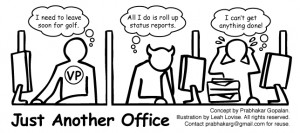After reading an interesting post in HBR (The End of the Middle Manager), I’m compelled to offer my response. I find the HBR post timely and noteworthy. Here we go.
First, let’s take a look at the classic product management/product marketing organization (PM/PMM): Pragmatic Marketing’s most recent survey of product management professionals tells us 63% of product managers report to either a ‘director’ or a manager. The other 37% report to an executive, and my guess is they work in small, nimble, flat organizations like start ups that reward productivity over process and cannot afford the deadweight of a middle manager. The focus of this post is the 63% that report to a director/manager and question the need for that middle manager role.
In my experience, most ‘director/manager’ of PM/PMM positions are limited to the following four duties:
- Tracking statuses of individual product managers in the team (and rolling up their status reports to report to the VP) – as indicated in Lynda Gratton’s research in the HBR post
- Combining individual product decks to a portfolio deck and presenting it as the company product strategy (in many instances there is no synergy among individual products; instead, they are merely grouped for organizational politics)
- Testing ground for people management skills of a product manager (often costly)
- Spending 25 to 30% of time on HR activities (e.g corporate compliance forms, expense approvals, HR training)
Next, in regard to the HBR post I referenced above, I found the following excerpt to be particularly striking: “Gen Y workers see no value in reporting to someone who simply keeps track of what they do, when much of that can be done by themselves, their peers, or a machine. What they do value is mentoring and coaching from someone they respect. Someone, in other words, who is a master—not a general manager.”
Based on my personal experience with product management & product marketing, HBR’s observations are not far from the truth in many (though I’m tempted to say ‘all’!) PM & PMM organizations. Rather than proving useful, ‘directors’ often exhibit one or more of the following ‘occupational hazards’:
- Having no (or little) idea about the products
- Mostly managing up
- Rolling presentations up/down the organizational chain
- Spending inordinate amounts of time on meetings because he/she is representing the whole team
If you find the above characteristics present in your current PM/PMM organizations, it may be time to consider an organizational redesign. The next time your ‘director of PM/PMM’ is out of the office with no access to his/her email or telephone for a full week, consider the following questions: What happened? Were interactions between the executive team and the frontline PM/PMM more fruitful? Did you still see a need to pay someone to act as middle manager between the PM/PMM and the executive team? Was productivity halted when the middle manager was out of the office?
If your organization’s needs are not being fulfilled, it may be time to consider dispensing of your ‘director’ of product management/product marketing. Here’s a quick assessment to help you judge for yourself:
Is a middle manager in the PM/PMM organization necessary for your business?
Can you dispense of the ‘director’ of product management/product marketing role in your organization? Here are four question areas to consider:
- Does the role offer anything beyond general management skills? In other words, does this person create anything of value or is he/she simply cutting and pasting, paraphrasing direct reports?
- Does this person prevent work from getting done? Does it take longer to create, plan, and execute tasks because this person sits between the doer and the executive who approves the budget/resource?
- What original deliverables did the middle manager create in a calendar year?
- Is this ‘director/manager’ a master of anything? Ideally, the answer should not be the unary ‘people management’.
Answers to the four questions above should help you decide on the necessity of a full time middle manager solely for ‘managing’ PM/PMM members of your organization. When organizational designs are tending to flatter, faster and effective models, it is time to inspect the PM/PMM organization and challenge widely accepted models.
